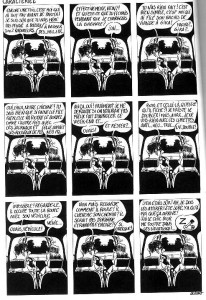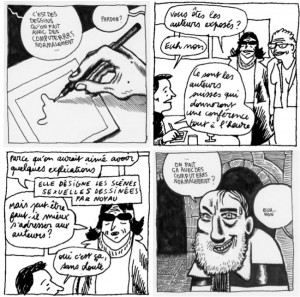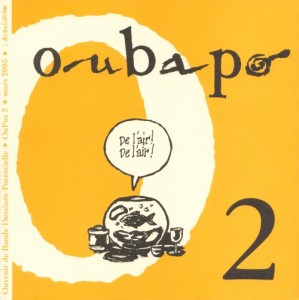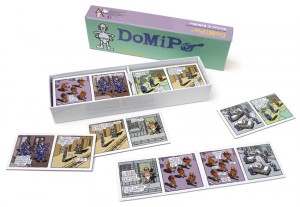“Oubapiens are rats which have to build the labyrinth of which they suggest going out.”
Acronym of Ouvroir de Bande dessinée Potentielle, the OuBaPo was established in November, 1992 within the Ou-X-Po and through the publishing house L’Association. This committee creates comic strips under voluntary artistic constraint in the style of the OuLiPo, Ouvroir de Littérature Potentielle, introduced by Raymond Queneau and François Le Lyonnais at the end of the 50’s.
During the first working session at the beginning of 1993, the group is formed of François Ayroles, Anne Baraou, Gilles Ciment, Jochen Gerner, Thierry Groensteen, Patrice Killoffer, Étienne Lécroart, Jean-Christophe Menu and Lewis Trondheim. Groensteen tells to want to leave it in 1999, in disagreement at the same time with the politic at that time, more turned to the performances than the publications, and with the allegiance of the movement at L’Association, but also and especially because he did not feel the soul of a formal creator. We shall note that in the OuBaPo, as in the OuLiPo and in all OuXPo, it is possible not to participate any more in an ouvroir, but it is not possible either to leave it, or to be excluded from it (in reaction to the controversies of the evictions deafening of the surrealist movement decreed by Breton André, and that Raymond Queneau, CEO and founder of the OuLiPo, and ex-brother-in-law of Breton lived).
Also collaborated in Oupus or published stamped books “Oubapo”: Stanislas Barthélémy, Denis Bourdaud, Philippe Coudray, Emmanuel Guibert, Matt Konture, Axel Renaux, Vincent Sardon, Joann Sfar, Tanitoc, Jean-Michel Thiriet, the swiss Ibn Al Rabin, Alex Baladi, Andréas Kündig, spanish Sergio Garcia. An American ouvroir exists also piloted by Matt Madden.
We can define a little better which are the formal constraints that stand out the authors in the realization of an album upon character OuBaPien. A first classification of the constraints was made and published in the first one Oupus by Thierry Groensteen in 1997 and is entitled Un premier bouquet de contraintes. The constraints can be distinguished in generative constraints and transformer ones..
- Reduction : A book or comic summarized in very few panels.
- Reversibility : A comic that can be read back to front.
- Iconic Alliteration : The same drawing reproduced throughout the whole comic with only the words changing.
Etc.
An work of oubapo can not be limited to a precise constraint but in this spirit to mix several types of different constraints.
We realize that these constraints, whatever they are, are very difficult to set up and ask for a lot of imagination on behalf of the authors, for this to create a comic strip not only ” in constraints ” strong on a technical plan but telling a real story. The proposed list is not exhaustive of course because potentially unlimited as long as the imagination of the authors does not dry up.
Artistic value and intellectual interest: to judge productions of oubapo according to the usual aesthetic criteria is ineffective. Indeed, based sometimes on very strong constraints, they often seem forced, and seemed to be more on the stylistic composition or the entertainment (what appears even more with the foldings) that on the work. Beyond the ” wholesome critic of the naive ideology of the expression and the inspiration “, their contribution in the comic strip is nevertheless real, so much they “make feel how much a comic strip is an organic totality, among which the various ingredients and the parameters are taken in a tight network of mutual determinations.”
Thierry Groensteen finds three main contributions: by underestimating the importance of the drawing, in the graphic reinterprétations or the comic strips without drawings, the OuBaPo reminds at the same time that the essence of the comic strip is not in the representation but in “the space agency of the multiframe, surrounded by a sequential speech” and that texts and drawings are totally interdependent ; by manhandling the homogeneity of the style, “Oubapo participates in the advent of a wide open conception of the comic strip”; the exercises of the pluri-readability “encourage translineary readings” and less conventional approaches of the story, while reminding the importance of the sequentiality.
Four Oupus were published, browsing the diverse researches, to which are added the individual works of its members and sympathizers (see bibliography below).
OuBaPo bibliography :
- Oupus 1, 2, 3 et 4 (L’Association) : the few cofounders and their first collaborators presents a few works, with full explanations about each new constraint…
- Ratatouille, by Étienne Lécroart (Seuil, 1999)
- Cercle Vicieux, by Étienne Lécroart (L’Association, 2000)
- Le Cycle, by Étienne Lécroart (L’Association, 2003)
- Le Dormeur, by Lewis Trondheim (Cornelius)
- Moins d’un Quart de Seconde pour Vivre, by Lewis Trondheim and J-C Menu (L’Association)
- Les Aventures de Julius-Corentin Acquefacques, by Marc-Antoine Mathieu (Delcourt)
- Jean qui Rit, Jean qui Pleure, by François Ayroles (L’Association)
- Nogegon, by Luc and François Schuiten
- TNT en Amérique, by Jochen Gerner (L’Ampoule)
- La Nouvelle Pornographie, by Lewis Trondheim (L’Association)
- Les Trois Chemins, by Lewis Trondheim and Sergio Garcia (Delcourt)
- Les Penseurs, by François Ayroles (L’Association)
- Les Parleurs, by François Ayroles (L’Association)
- Coquetèle, d’Anne Baraou by Vincent Sardon (L’Association, 2002)
- Morphologie Variable, by Stéphane Blanquet (L’Association, 2001)
- Comique Trip, by Benoît Jacques (Benoît Jacques Books, 2001)




